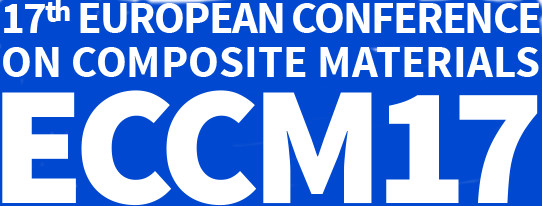

App-Einstellungen:
OUT OF DIE ULTRAVIOLET PULTRUSION PROCESS SET-UP: LIMITATIONS OF PHOTO-DIFFERENTIAL SCANNING CALORIMETRY ANALYSIS
Iosu Tena (University of Mondragon) Iván Sáenz Domínguez (Mondragon Unibertsitatea) Modesto Mateos (Mondragon Unibertsitatea) Mariasun Sarrionandia (Mondragon Unibertsitatea) Jon Aurrekoetxea (Mondragon Unibertsitatea)
The aim of this study is to analyse the limitations of the traditional photo-differential scanning calorimetry (photo-DSC) analysis compared to electric monitoring (DC sensor) in the out of die ultraviolet (UV) pultrusion process set-up.
EFFECTS OF HEATING CONDITIONS ON HIGH FREQUENCY INDUCTION WELDING BEHAVIOR OF CARBON FIBER REINFORCED THERMOPLASTIC COMPOSITES
Tanabe Daiki (Osaka University) Kai Kurauchi (Kindai University) Yusuke Kawamura (Kindai University) Kazuaki Nishiyabu (Kindai University) Tetsusei Kurashiki (Osaka University)
This study aims to reveal the induction welding behavior of CFRTP composites by high-frequency induction heating method. The effects of heating conditions were investigated to predict the optimum processing conditions.
HEATING CARBON/THERMOPLASTIC FIBRE HYBRID NONWOVENS USING MICROWAVES TO PRODUCE ORGANO SHEETS
Thomas Köhler (RWTH Aachen University) Gunnar Seide (RWTH Aachen University) Thomas Gries (RWTH Aachen University)
Fibre reinforced thermoplastic composites have become increasingly important in the industry. Shorter cycle time can be achieved by quick heating. The volumetric heating of microwave technology can be used to heat carbon/polyamide hybrid nonwovens.
MICROWAVE HEATING OF A COMPOSITE PART
Anais Barasinski (Ecole Centrale de Nantes) Hermine Tertrais (Ecole Centrale de Nantes) Chady Ghnatios (Notre Dame University-Louaize) Francisco Chinesta (Ecole Centrale Nantes)
The principal objective of this work is to model and simulate the interactions of the MW field with a composite laminated part, consisting of a stack of layers of different orientations, each layer made of resin matrix and carbon fibers.
PROCESS DEVELOPMENT FOR GENERATIVE MANUFACTURING OF FIBER THERMOPLASTIC COMPOSITES STRUCTURES – THERMOPLASTIC PATCH PLACEMENT (TPP)
Philipp Schwanemann (Institut für Leichtbau und Kunststofftechnik) Niels Modler (Technical University of Dresden) Bernhard Witschel (Institut für Leichtbau und Kunststofftechnik) Bernd Grüber (Institut für Leichtbau und Kunststofftechnik) Florian Lenz (Leichtbau-Zentrum Sachsen)
Development of a novel process for the generative manufacturing of load-adapted curved composite shell structures. The Thermoplastic Patch Placement (TPP) process utilizes thermoplastic sheets for generative manufacturing structures.
PROCESSING OF FIBRE REINFORCED THERMOPLASTIC COMPOSITES WITH ENHANCED THERMAL PROPERTIES
Georg Brockerhoff (RWTH Aachen University) Robert Brüll (RWTH Aachen University) Thomas Gries (RWTH Aachen University) Gunnar Seide (RWTH Aachen University)
This paper evaluates the effects of 5 weight percent (wt.-%) titanium dioxide (TiO2) in commingled hybrid yarns made of polyamide 6 (PA6) glass fibres on the cycle time during the consolidation process and the resulting mechanical properties.
RAPID MANUFACTURING OF COMPOSITE STRUCTURES MADE OF FABRIC FLAX / POLYPROPYLENE
Imed Derbali (Ecole Nationale Supérieur d'Arts et Metiers) Svetlana Terekhina (Ecole Nationale Supérieur d'Arts et Metiers) Laurent Guillaumat (Ecole Nationale Supérieur d'Arts et Metiers) Pierre Ouagne (ENI Tarbes/ Université Orléans)
This paper present a new rapid manufacturing process of composites parts based on flax/PP comingled fabric. Then, an assessment of the new process by comparing the mechanical properties of a material produced by a traditional process will be presented.
AN ANALYTICAL MODEL FOR PREDICTING CRITICAL FEED RATE IN DRILLING OF COMPOSITE MATERIALS
Navid Zarif Karimi (University of Bologna) Hossein Heidary (Tafresh University) J. Yousefi (Amirkabir University of Technology) Giangiacomo Minak (University of Bologna)
In this paper, elastic fracture mechanics, classical plate bending theory and the mechanics of oblique cutting were used to predict critical thrust force and feed rate at the onset of delamination in drilling of composite laminates.
WET MACHINING OF CFRP
Marco Schneider (Fraunhofer IPA) Andreas Gebhardt (Fraunhofer IPA) Robert Beckenlechner (Fraunhofer IPA)
In this article, the potential of wet machining of CFRP is illustrated by means of the milling process.
AUTOMATED HANDLING OF AUXILIARY MATERIALS FOR VACUUM BAGGING IN CFRP FUSELAGE PRODUCTION
Jan Faber (German Aerospace Center) Clemens Schmidt-Eisenlohr (German Aerospace Center)
Vacuum infusion techniques and especially vacuum bagging involve a high amount of manual work. To increase productivity and efficiency, robot-based gripping systems could be used. Alongside the process chain, optimization potentials are discussed.
